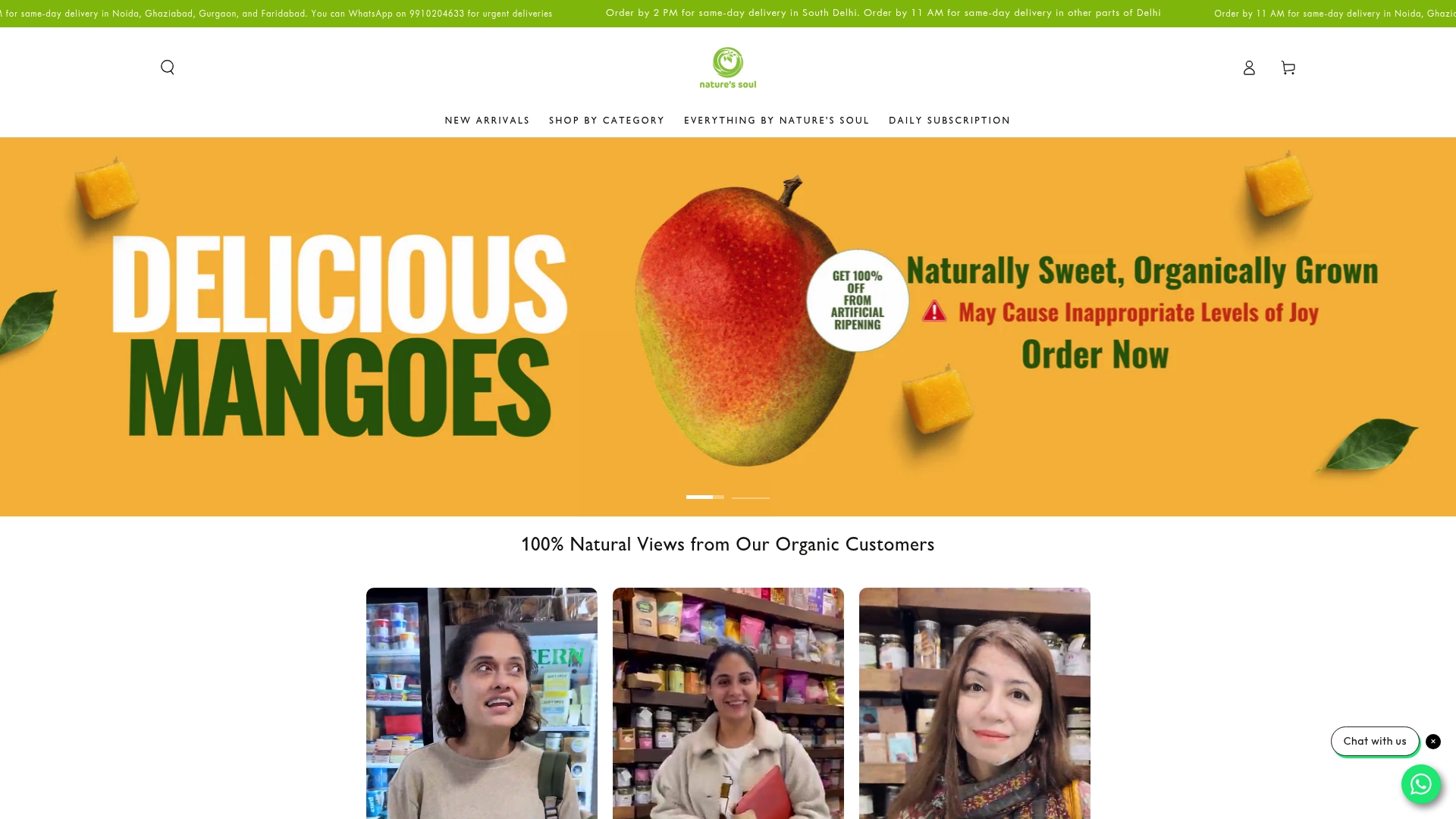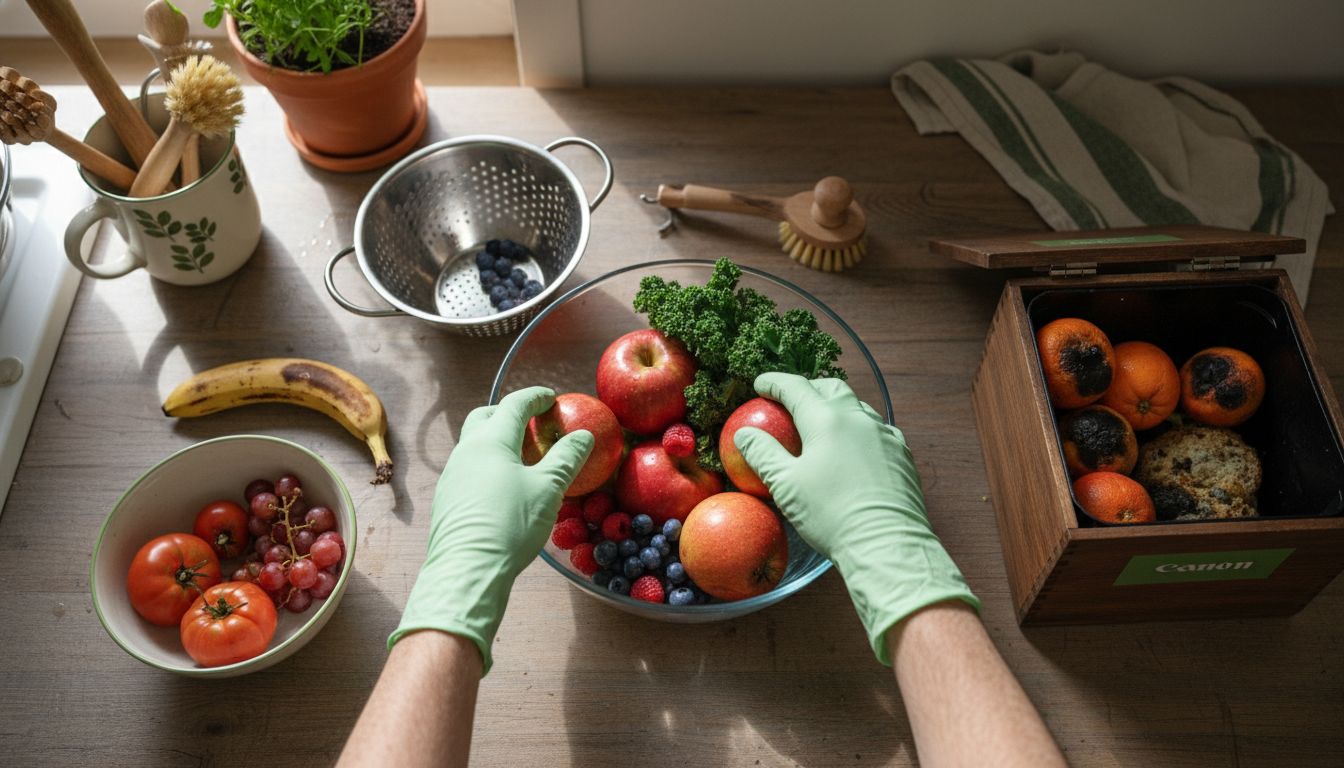Over a third of all food produced is lost or wasted before hitting your plate. Food safety and freshness start with simple but effective storage habits at home. Whether you want to protect your family from harmful bacteria or simply keep your groceries at their best, a few smart changes can make a big difference. This guide reveals how proper organization, cleaning, and storage can keep your fresh food safe and flavorful for longer.
Table of Contents
- Step 1: Prepare Storage Areas For Optimal Hygiene
- Step 2: Sort And Clean Fresh Produce And Perishables
- Step 3: Select Suitable Containers And Wraps
- Step 4: Organize Food By Type, Ripeness, And Storage Needs
- Step 5: Check Freshness Regularly And Rotate Stock
Quick Summary
| Key Point | Explanation |
|---|---|
| 1. Maintain hygienic storage areas | Keep storage areas clean to protect food quality and safety, preventing contamination risks. |
| 2. Sort and clean produce effectively | Check ripeness and cleanliness; dispose of moldy items and use FIFO for managing inventory. |
| 3. Use appropriate containers and wraps | Choose proper storage solutions; use airtight or breathable containers based on produce type. |
| 4. Organize food by type and ripeness | Categorize and label items effectively to maximize freshness and minimize waste. |
| 5. Regularly check freshness and rotate stock | Perform weekly checks and apply FIFO to ensure the oldest items are used first, reducing spoilage. |
Step 1: Prepare storage areas for optimal hygiene
Preparing clean and hygienic storage areas is crucial for maintaining the quality and safety of your fresh food. By establishing proper storage practices, you protect your produce and prevent potential food contamination risks.
Start by creating a systematic approach to food storage hygiene. According to Penn State Extension, using separate cutting boards for fresh produce and raw meats is essential. Designate specific surfaces for different food types to prevent cross contamination. Clean all countertops, cutting boards, and utensils with hot soapy water after each use, and consider creating a sanitizing solution of one teaspoon chlorine bleach per quart of water for additional disinfection.
Your refrigerator storage strategy matters significantly. As Illinois Extension recommends, store prepackaged and precut produce at temperatures below 41°F. Arrange your refrigerator strategically by placing fresh produce in high humidity compartments and ensuring it remains separate from raw meats. Cover stored items and position them above any uncooked proteins to minimise potential contamination risks. A well organised refrigerator not only maintains food safety but also helps preserve the freshness of your ingredients.
Step 2: Sort and clean fresh produce and perishables
Sorting and cleaning your fresh produce is a critical step in maintaining food quality and preventing potential health risks. This process helps you identify which items are ready to use and ensures your fruits and vegetables are clean and safe for consumption.
According to Penn State Extension, start by sorting your produce based on ripeness and quality. Fully ripe and over-ripe items should be used first, while moldy produce must be discarded immediately. Fruits and vegetables with minor imperfections like soft spots or small bruises can still be salvaged for cooking. Implement the ‘First in, First Out’ (FIFO) principle to manage your produce inventory effectively.
For cleaning, Minnesota Extension recommends thorough hand washing with warm soapy water for at least 20 seconds before and after handling food. Remove outer leaves from produce like cabbage and corn, then rinse under cool running water. Avoid using hot water, which can damage delicate produce. Air dry your fruits and vegetables or use a clean disposable towel to prevent recontamination. By following these steps, you’ll ensure your produce remains fresh, clean, and ready for preparation. Learn more about local produce in our comprehensive guide on the benefits of local produce.
Step 3: Select suitable containers and wraps
Choosing the right containers and wraps is crucial for preserving the freshness and quality of your food. The right storage solutions can significantly extend the shelf life of your produce and prevent unnecessary waste.
According to Illinois Extension, when storing fresh produce, temperature and placement are key considerations. Aim to keep prepackaged and precut produce at temperatures below 41°F and always cover your stored items. Position your containers strategically in the refrigerator, placing produce above raw meats to prevent potential cross contamination. Look for high humidity closed containers that help keep fruits and vegetables crisper for longer periods.
For container hygiene, Penn State Extension emphasises the importance of cleanliness. Clean all containers thoroughly with hot soapy water before use, and consider sanitising them with a mild bleach solution. Glass and hard plastic containers with tight sealing lids work best for most produce. Breathable produce bags can be excellent for items like leafy greens, while airtight containers are ideal for more delicate fruits and cut vegetables. Explore our comprehensive guide on zero waste grocery shopping to learn more about sustainable food storage practices.
Step 4: Organize food by type, ripeness, and storage needs
Effective food organization is more than just tidying up your refrigerator. It is a strategic approach to preserving food quality, reducing waste, and ensuring you always have fresh ingredients ready for cooking.
According to Penn State Extension, implementing the ‘First in, First Out’ (FIFO) principle is crucial. Sort your produce by ripeness, using fully ripe and over-ripe items first. Produce with minor imperfections can be repurposed for cooking, while moldy items should be discarded immediately. Consider labelling your items with dates to help track their freshness and manage your inventory more effectively.
When storing different food types, Illinois Extension recommends maintaining temperatures below 41°F and strategically positioning items in your refrigerator. Store prepackaged produce in high humidity compartments, and always place fresh items above raw meats to prevent cross contamination. Different foods have different storage needs some prefer cool dark spaces, while others thrive in specific humidity levels. Learn more about meal prepping vegan dishes that maximize ingredient freshness to complement your food organization strategy.
Step 5: Check freshness regularly and rotate stock
Regularly monitoring your food inventory is key to preventing waste and ensuring you always have fresh ingredients on hand. Think of it as a proactive approach to maintaining the quality and safety of your food storage system.
According to Penn State Extension, implementing the ‘First in, First Out’ (FIFO) rule is crucial for effective stock rotation. Systematically check your produce for signs of ripeness or spoilage. Use fully ripe items first and be prepared to repurpose produce with minor imperfections for cooking. Soft spots or slight bruising do not necessarily mean an item needs discarding. Take time to label items with dates to make tracking easier and more efficient.
Temperature plays a critical role in food preservation. Illinois Extension recommends keeping prepackaged produce at temperatures below 41°F and storing them in high humidity compartments. Perform weekly inventory checks, moving older items to the front and newer items to the back. This practice helps prevent forgotten foods from spoiling and ensures you are consistently using the freshest ingredients possible. Explore our guide on meal prepping vegan dishes to help you make the most of your carefully maintained food stocks.
Keep Your Fresh Food Naturally Fresh with Confidence
Storing fresh food safely and effectively can feel like a constant challenge. The anxiety of losing quality produce to spoilage or cross contamination is real and frustrating. This article highlights how important it is to prepare storage areas hygienically and organise your food with care using principles like FIFO for maximum freshness. At Nature’s Soul Shop, we understand your goal to preserve natural quality while embracing clean, organic ingredients that support wellness and reduce waste.

Experience the difference with our wide selection of organic fruits, vegetables, and thoughtfully sourced products designed to complement your careful food storage routine. Act now to ensure every meal is made from the freshest ingredients possible. Visit us today at Nature’s Soul Shop and explore tips on meal prepping vegan dishes and the benefits of local produce for a natural lifestyle that supports your health and the planet. Start your journey towards effortless freshness today.
Frequently Asked Questions
How do I prepare storage areas for storing fresh food naturally?
To prepare storage areas for maximum freshness, clean all surfaces, cutting boards, and utensils with hot soapy water after each use. Designate areas for different food types, such as using separate spaces for produce and raw meats to avoid cross-contamination.
What is the best way to wash fresh fruits and vegetables?
The best way to wash fresh produce is to rinse it under cool running water while removing any outer leaves or damaged spots. Do this for at least 20 seconds to ensure all dirt and contaminants are removed before consumption.
How should I organize food in my refrigerator for maximum freshness?
Organize food by type and ripeness, using the ‘First in, First Out’ (FIFO) method to consume fully ripe items first. Keep prepackaged produce in designated high humidity compartments and always store fresh items above raw meats to prevent contamination.
What containers are best for storing fresh food?
Use airtight containers for delicate fruits and vegetables and breathable produce bags for leafy greens to maintain freshness. Ensure that all containers are thoroughly cleaned with hot soapy water before use to prevent recontamination.
How often should I check the freshness of stored produce?
Check your stored produce at least once a week to monitor freshness and identify any items needing to be used or discarded. Move older items to the front and place newer items in the back to minimize waste and ensure you use the freshest ingredients first.

What temperature should my refrigerator be set at for optimal food storage?
Set your refrigerator to maintain a temperature below 41°F to ensure the safety and freshness of your stored produce.
![]() Regularly check the temperature setting to avoid spoilage and enhance longevity.
Regularly check the temperature setting to avoid spoilage and enhance longevity.






